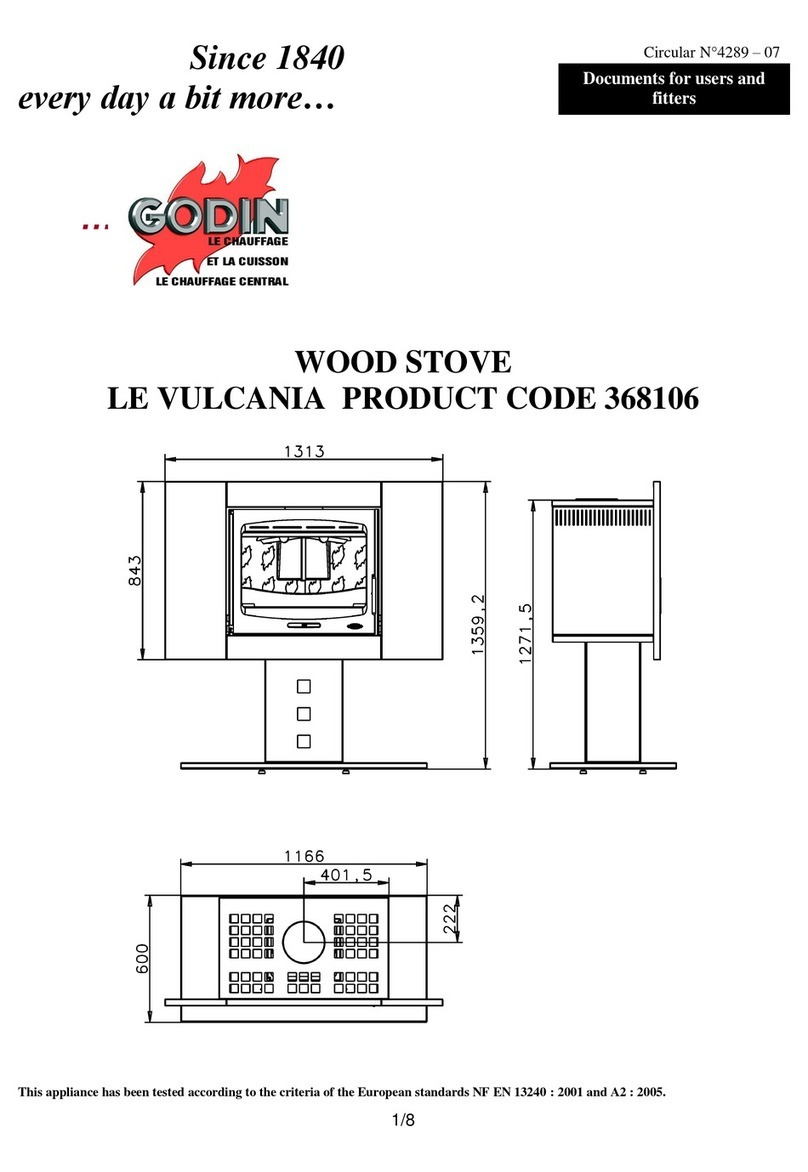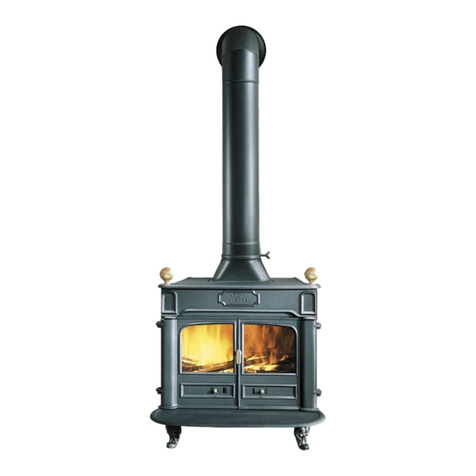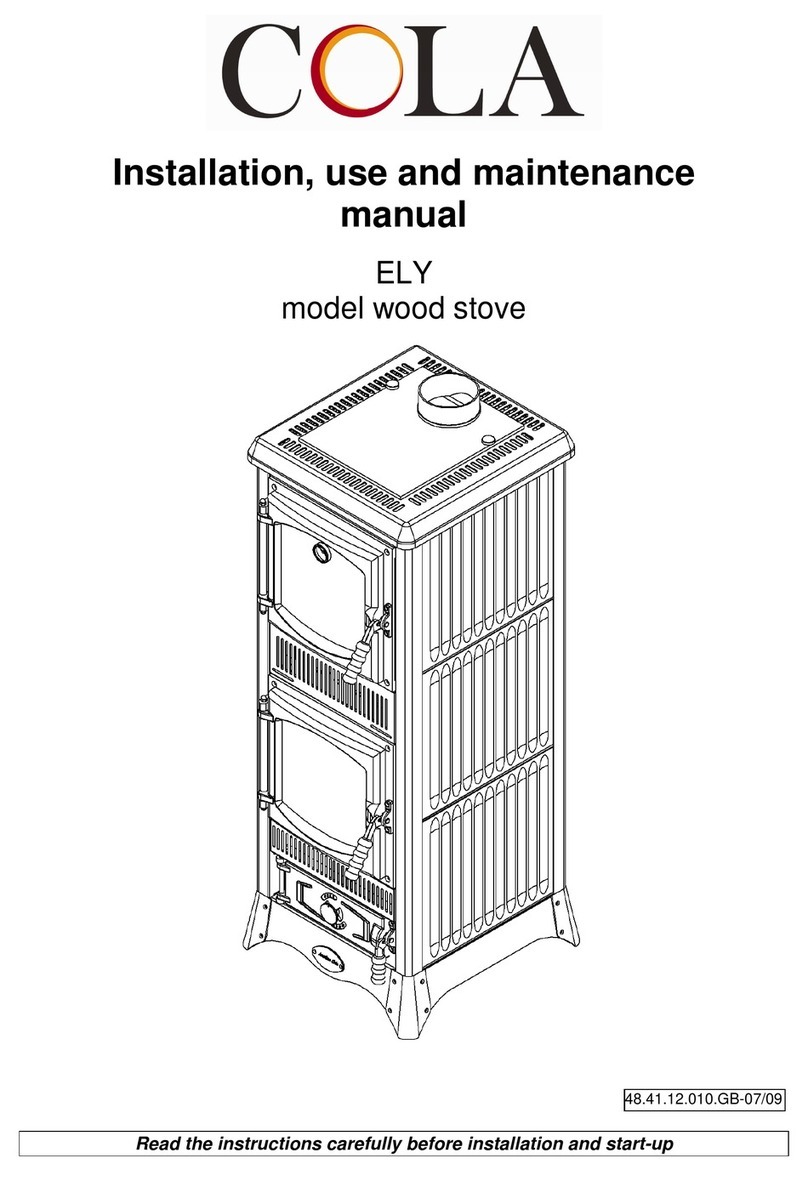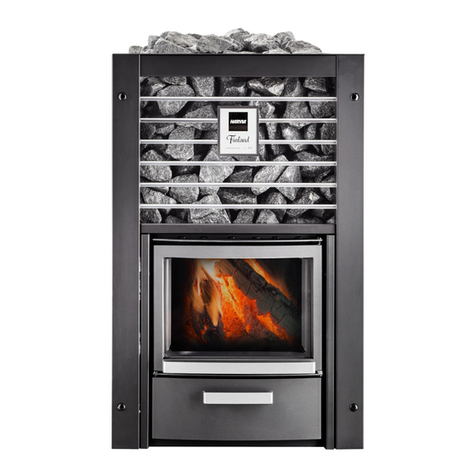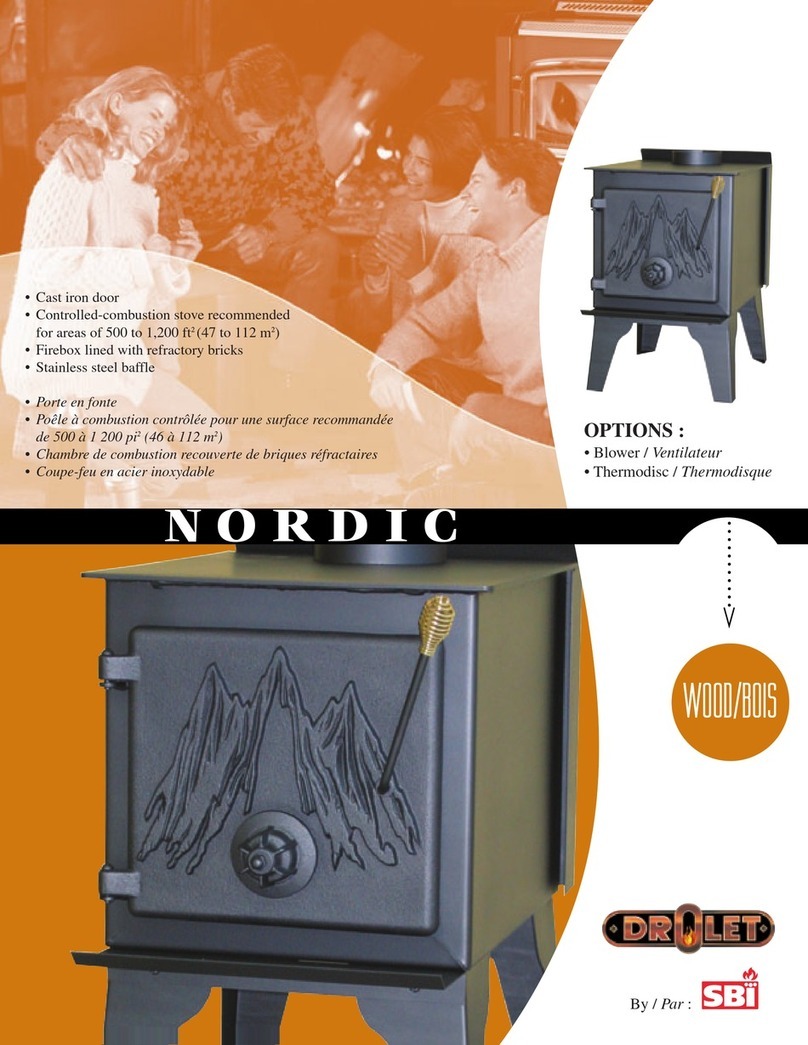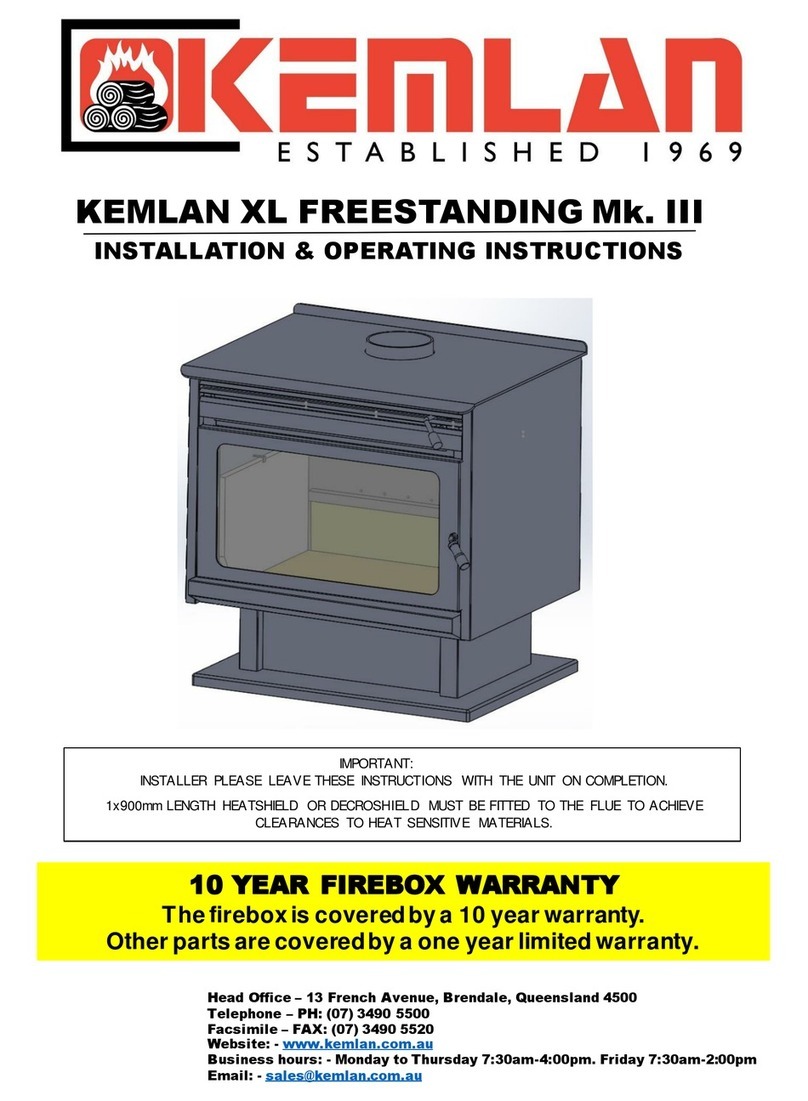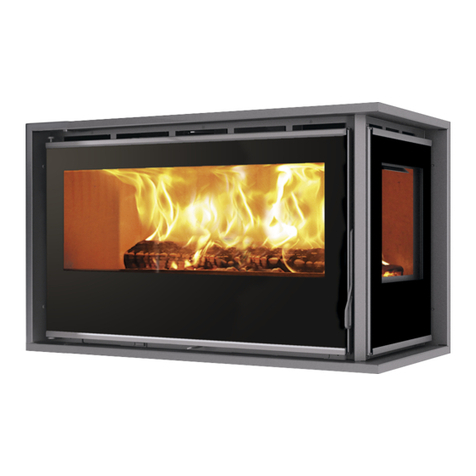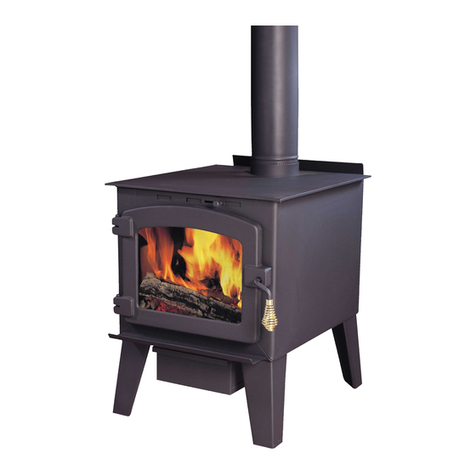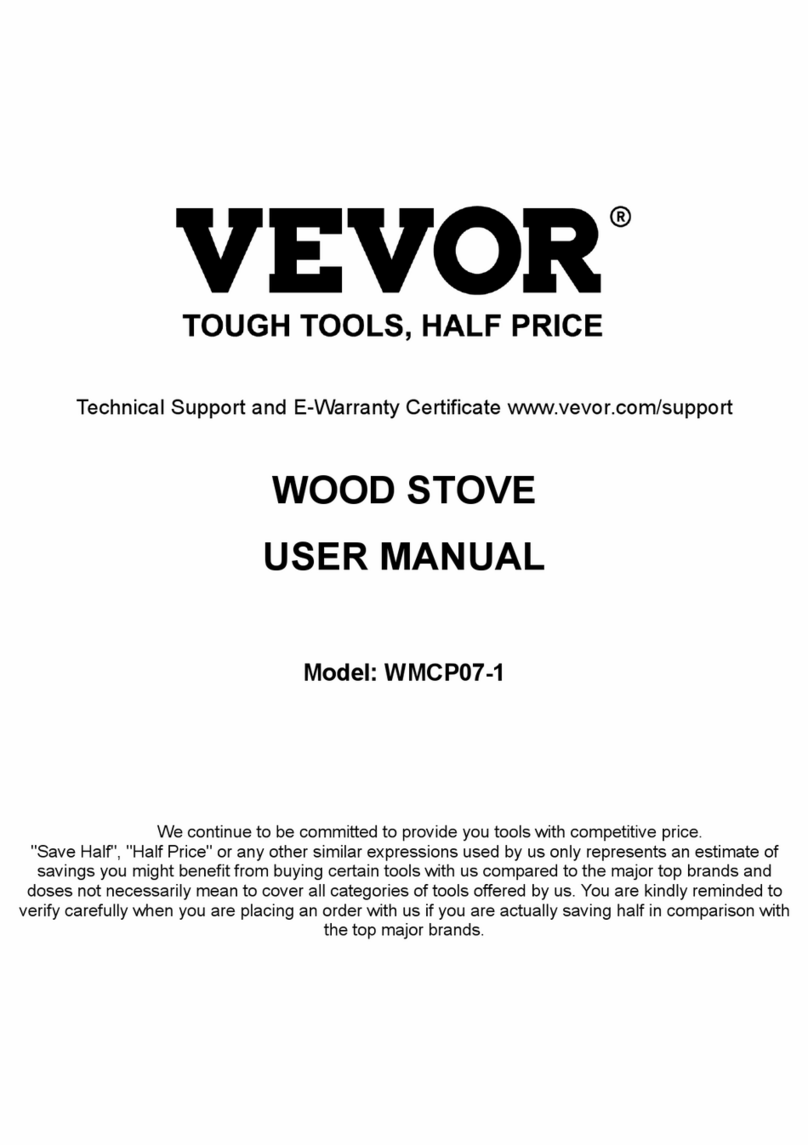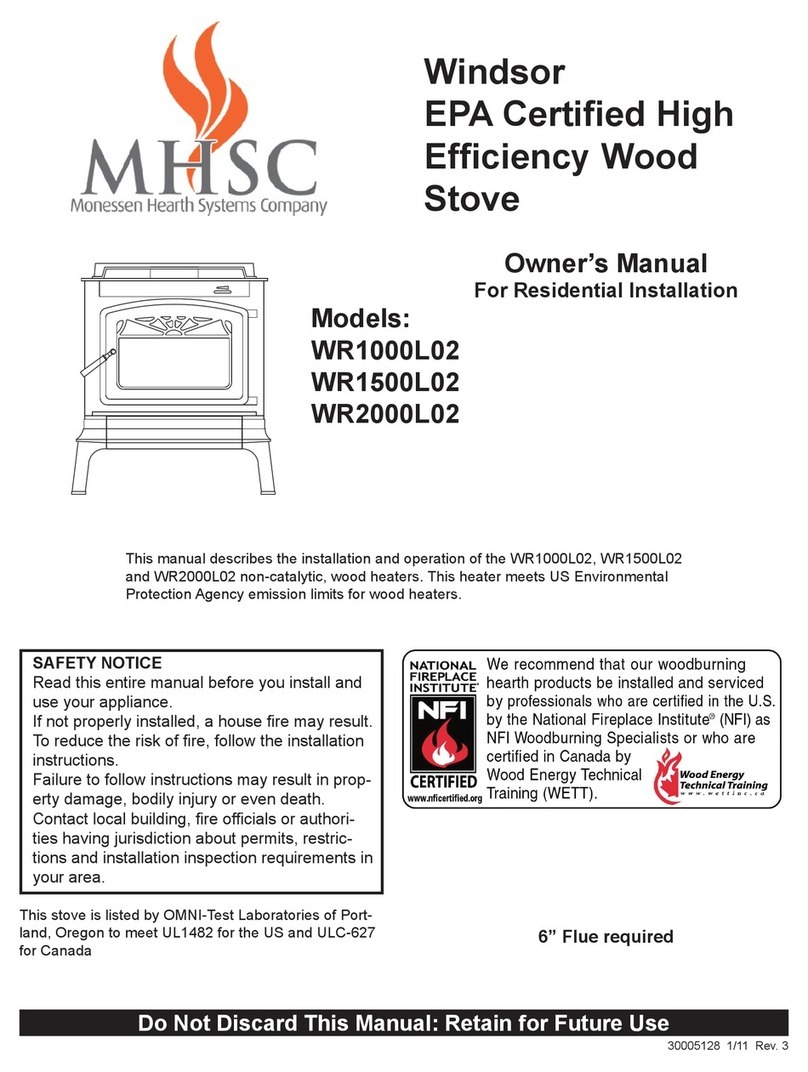Godin Promes User manual

1
PROMES –REF: 240175
WOOD BURNING
TECHNICAL CHARACTERISTICS
REF: 240175
Dimensions (W/D/H)
1023 x 668 x 845mm
Diameter of Outlet
150mm diameter
Flue Outlet
Top or rear
Combustible Material
Wood
Recommended fuel
33cm logs
Nominal kW Output
6.5 Kw
Regulation
Manual
Loading
Front Loading
Heating Volume
90 to 240 m3
Consumption
1.9kg per hour (wood with 20% humidity)
Weight
163kg
Glass
Heat resistant glass up to 750 deg C
Rate of emission of CO2
0.11%
Percentage of CO in fumes
0.11%
Minimum distance from
Combustible materials
40cm from rear, 40cm from sides, 150cm from front of unit
Average temperature of
fumes in °C
239
Fire box size (W/D/H)
270 x 400 x 340mm
Oven dimensions (W/D/H)
330 x 410 x298mm

2
LINEDRAWING FOR PROMES Ref: 240175
INSTRUCTIONS FOR THE INSTALLER
The stove is assembled and ready for connection. It must be connected to a flue for the
evacuation of fumes. Where possible, when connecting to an existing chimney, the length of the
joining connection must be kept to a minimum. All joins must be sealed. The diameter of the
connecting flue must always correspond, as a minimum to the diameter of the flue outlet.
Whichever outlet (top or rear) is not being used, it must be left sealed.
Fundamentals for correct operation of the unit –
1. The internal crossection should preferably be circular.
2. The chimney should be insulated and impermeable, constructed of fire resistant material
and resistant to condensation.
3. There should be no reductions in crossection of the chimney and off sets from the vertical
should not exceed 45 degrees.
4. An existing chimney should be cleaned.
5. Respect the technical characteristics given in the instruction manual.
If the chimney has a square or rectangular crossection, the internal corners should be rounded. A
minimum height of 4m is recommended otherwise the draw will be negatively affected. The
following products should not be used as they will affect the performance of the stove: fibre
cement, galvanized steel, rough and porous internal surfaces. In figure 3, some possible solutions
are shown. The minimum crossectional area of the chimney should be 20 x 20cm for units where
the outlet diameter is less than 200mm.

3
The draw created by your chimney should be sufficient but not excessive. A chimney that is too
large in crossection, can create problems as the internal volume is large and is difficult to heat. To
avoid this one may have to line the chimney along its full length with tubing of the correct diameter.
A crossection that is too small, on the other hand, will also reduce the draw.
The chimney must be made of inflammable material and be appropriately insulated. The same
chimney or tubing cannot be used for more than one installation (multiple fireplaces).
Always respect the regulations applicable to the country of installation.
Establish that the flue and chimney is of a high quality –it is the most important component
of the installation.
The flue/chimney ensures correct burning of primary air and the extraction of the
combustion gases.
Inferior performance of the stove is, in most cases, as a result of a problem with the
flue/chimney.
A good chimney should be made of material that does that not conduct too much heat nor
cool down easily.
The minimum diameter of the chimney may be 150mm. Where possible, it is recommended
to increase the flue size to 180mm.
There must be no reduction in the crossectional area. Any reduction in crossection will
cause turbulence and possible backdraft into the room as soon as the door of the stove is
opened.
The chimney must originate in the same room where the stove is installed.
Dampers should not be used.
The flue/chimney must be homogenous.
The flue/chimney/tubing must be able to resist to chimney fires. The flue used should be
rated to withstand temperatures 50 °C higher than the declared temperature for the stove,
whatever the installation method.
The chimney height must not be less than 4m and should end in “free air” at least 40cm
above the roof pitch or 40cm higher than any obstacle that is within an 8m radius of the
chimney.
A cowl should be installed.
The draw should be between 10 –15 pascals in normal operation and reduce to 5 pascals
on a slow setting. The draw should not reduce below 10 pascals when the stove is being
used normally as the performance will be negatively affected.
If the draw is far too high, a damper may be considered.
Any tubing used must be of high quality and conform to accepted norms.
It is recommended that a cleaning trap is placed 50cm below the base of the
flue/chimney.
Before connecting the stove, the integrity of the flue/chimney must be confirmed. If
necessary the flue must be cleaned.
The unit should be installed by a recommended professional with all national and local
regulations adhered to.
If there is an extractor in the same space as the stove, it may affect the performance of
the stove.
Other stoves/heaters working in the same space may also cause interference with the
draw.
Never block off existing ventilation points in the room. The unit uses the air coming into
the room for its performance and there should be sufficient renewal of this air in the
room.
These units are not designed to be connected to multiple chimneys.

4
The spigot may be connected either to the rear or top of the stove. The cover plate must
be attached to close off the outlet that is not used.
IMPORTANT
Verify the weight-bearing capacity of the floor. If necessary the unit could be placed
on a stone slab, tiled area or steel sheet for example.
If the floor is made of combustible material, it should be protected by a sheet of non-
combustible material which protrudes beyond the front of the unit by at least 40cm.
Use pipes of the specified diameter and preferably enameled as their resistance to
corrosion is higher.
The rear wall should not contain any combustible material; otherwise it should be
similarly protected.
The ceiling should be a minimum of 80cm above the top of the stove.
CONNECTION TO THE CHIMNEY
The unit should be connected according to accepted norms. This is especially important with
regard to combustible materials and insulation. No joins must be made within the actual thickness
of the ceiling itself.
Figure 3
If the unit is to be connected to an existing chimney, then the length of flue/tubing should be kept
to a minimum. The connection should always be made with good quality material. The internal
diameter of the connection must correspond to the external diameter of the spigot on the unit.
ATTENTION: If the connection has to go through combustible material, all material in a radius of
20cm around the pipe should be replaced by heat resistant material. For the unit to function well it
is important that here is sufficient air in the vicinity of the unit.
The pressure drop (draw) of the chimney should be between 10 –12 pascals. This measure can
only be attained when the unit is hot and operating normally. If the pressure drop exceeds 17
pascals, it should be reduced by installing a form of damper in the tubing/chimney.

5
THE IMPORTANCE OF AVAILABLE AIR FOR COMBUSTION AT THE UNITS POSITION:
As air is required for correct combustion in the stove, it is critical that there is enough available air
in the room. In the case of houses where the windows and doors seal completely (new
houses/green technology) the arrival of fresh air in the room is not guaranteed. This could
compromise the draw of the unit as well as your own safety. Consequently, a supplementary
source of air providing external air close to the unit should be allowed for (possibly a conduit
through an external wall or into a well-ventilated adjoining room. It is expressly forbidden to have
the supplementary source of air coming from the same room where a boiler is situated or from the
garage. An air supply pipe should be smooth, a minimum of 120mm in diameter, be a maximum of
4m in length and should not have more than 3 bends along its length. If it is going directly outside,
it is advised to have a fixed louvre on the outside.
The air supply should not be closed off when the unit is burning. When the unit is functioning
correctly with the natural draw of the chimney, a volume of air of 20 m³/hr is required. Natural
circulation of air should be allowed for in the room. One should be aware that if there is a working
extractor in the same room –the extractor creates a low pressure point in the room in order to
evacuate fumes and smoke. In the worst case, this could even cause the stove chimney to draw
fumes back down the chimney and into the room –with very dangerous consequences.
INSTRUCTIONS FOR THE USER:
The wood burning stove is designed to allow you to cook on the top surface and to heat the room
at the same time. It can also be used for heating throughout the year. The unit is designed to only
burn wood. The stove is made of enameled steel sheets, and some enameled cast iron parts. The
door has a panoramic ceramic glass fitted, resistant to 700 °C, allowing a good view of the fire and
preventing escaping fumes and sparks. The internal firebox is lined with individual cast iron plates
and a flat grate at the bottom. Beneath the oven door is a warmer drawer –never put flammable
materials in this drawer. Radiant heat is transmitted through the external surfaces of the stove.
The stove has primary and secondary air intakes to regulate combustion.
Before using the stove, read the instructions.
The unit must be installed following all accepted norms and regulations.
It is highly recommended that a professional installer is used.
Never close off the air intakes.
The unit must be connected to its own chimney. Never use multiple chimneys.
Do not modify the unit.
The unit must be used with the door closed.
All surfaces of the unit get hot, please take all precautions to prevent burns.
Keep child and the elderly away from the unit, in order to prevent accidents.
Assure yourself that you have a good draw by adjusting the air intake lever on the front of
the unit.
PERFORMANCE OF THE UNIT:
Always follow the instructions.
When lighting for the first time, use a small load of wood to verify that the unit is working
properly. Slowly increase the load over a period of several days.
Do not use the unit as an incinerator.
Only use the recommended fuel –wood.
After a long period of non-use, check that the chimney is clear as well as any air intakes,
etc.

6
LIGHTING:
Important: it is inevitable, that an acrid smell is produced when lighting the unit for the first time
(due to the drying of adhesives used in joints and some protective coatings). This smell will
disappear after a short period of use. For this reason, good ventilation of the room is required.
When lighting the unit for the first time, it is recommended that a small amount of wood is used
and that this is slowly increased to increase the calorific output of the unit.
When lighting a unit, for the first time, that is made of materials coated with a high temperature
“varnish”, one must know that:
Several different materials are used in the manufacturing of the unit –cast iron, steel,
ceramic products.
The temperatures that the body of the unit is subjected to are not uniform. The temperature
range across the different parts of the stove can vary from 300 - 500°C.
Through its life, the unit is subjected to alternating cycles of lighting, steady burning, periods
of intensive use and non-use through the different seasons.
The new unit, before being considered “broken in”, will have been through several different
burning cycles, so that all the materials and paints will have completed their varying
expansion and contraction stages.
Right at the beginning the smell will be typical of metal subjected to a high temperature and
fresh “varnish”. This coating, even though it is baked at 250°C, for several hours when it is
manufactured, has to exceed a temperature of 350°C several times before it is perfectly
absorbed into the metallic surfaces.
It is therefore important to take these precautions when lighting:
1. Assure yourself that there is a renewal of fresh air in the room where the unit is installed.
2. When lighting the unit for the first time, do not excessively load the firebox
(approximately half of what is indicated in the instruction manual) and keep the unit lit for
approximately 6-10 hours continuously, with only moderate adjustments to the air
intake.
3. If you are able to, it is recommended to follow this process four or five times.
4. Following this, you may increase the load more and more but taking care not to exceed
the maximum load. At the beginning it is better to have longer burns than many cycles of
burning and non-burning.
5. During the first burnings of the unit, nothing should touch the unit –especially any
surface that may be lacquered. The lacquered surfaces should not be touched during
heating.
6. After your unit has been “broken in” you can use it by avoiding sudden heating and
excessive loads.
To light the fire we suggest using kindling and newspaper or other commercial products, except
using any liquid fuels (e.g. petrol, alcohol). The primary and secondary air intakes must be open at
the same time, the regulator for the oven use must be adjusted so that the lever is pushed in
towards the rear of the stove.
When the wood starts to burn, you may load more wood, and adjust the air according to the
paragraph on “NORMAL OPERATION” (see below). During this stage do not leave the stove
unattended.
Never over load the stove. Too much wood and too much air for combustion can cause over
heating and damage the unit. The guarantee does not cover over heating.

7
NORMAL OPERATION:
The unit must be connected to its flue/chimney. The door to the unit must only be opened when
someone is in attendance. For safety reasons, the door should only be opened for loading wood
into the firebox. The firebox must stay closed during operation and during periods of non-use. The
unit must always be used with the door closed otherwise one would create the effect of an open
furnace.
The air controls on the front of the stove regulate the emission of heat from the fire. They must be
opened in accordance with the required calorific output. Better combustion is obtained (minimal
emissions) when, on loading the wood most of the combustion air passes through the secondary
air channel. In order to obtain the maximum calorific output, with a chimney draw between 10-12
pascals is the following:
Primary air intake –2/3 open
Secondary air intake –20mm open
Hourly consumption –1.9kg
The combustion intensity and, by consequence, the calorific output of your stove are in influenced
not only by the air regulation but also by your chimney. IMPORTANT: In order to assure correct
combustion of your stove, ensure that the smoke coming out of your chimney is clear. If the smoke
is white, this indicates that the stove is not correctly regulated or that the wood is too wet. If on the
other hand the smoke is grey or black, it means that complete combustion is not occurring.
USE OF THE OVEN:
The air supply to the firebox will affect the oven temperature. A good draw and clean flue/chimney
will allow optimal circulation of hot fumes around the oven necessary for successful cooking. The
oven rack may be put at different levels. Thick cakes and large roasts should be placed on the
lowest level. Thin cakes and biscuits in the middle and the upper level should be used to reheat or
simmer food.
OPERATION IN TIMES OF TRANSITIONAL WEATHER:
During a period of transition; for example when outside temperatures increase, one could pick up
problems with smoke evacuation. The result is that gases produced during combustion may not be
completely discharged and one may have a gas odour. In this case, one should more frequently
riddle the ash grate and increase the air supply. A smaller load of wood should be used ensuring
that this burns more rapidly (with more flames) and that the draw up the chimney stabilizes. One
should also ensure that any cleaning traps and connections to the chimney are sealed.
MAINTENANCE:
ATTENTION: When lighting the unit for the first time, it must operate at a reduced rate to
allow the parts to settle correctly. The handles are hot during use and the glove should be
used (if supplied). The glove should only be used for opening and closing the door
handles. It is not to be used as a fire glove to pick up burning embers. It is not impermeable
to liquids and it must not be used as a barrier to chemicals. When not in use the glove
should be kept on a cool surface.
The chimney should be inspected once a year. The enameled parts of the stove may be cleaned
with a bit of water and a mild, non-abrasive detergent. Any brass parts may be cleaned with
suitable commercial products.

8
It is recommended that only genuine parts authorized by GODIN are used. If required, please
contact your qualified reseller.
Your unit must not be modified.
CLEANING THE FLUE/CHIMNEY:
The correct lighting procedure, using the correct quantity and quality of wood, a good chimney
draw and the presence of fresh air combine to create optimal conditions for the correct operation
of the stove.
A complete cleaning is recommended twice a year or every time that it is necessary (problems
with the draw). This cleaning can only occur when the unit is cold and should be done by a
qualified chimney sweep who can check the stove at the same time.
The smoke collection compartment can be cleaned through a small opening below the oven (after
having unscrewed the screws that hold the covering panel to the face of the stove).
Ensure that the smoke deflector plate is installed as shown, or one can do this from the top. In this
case, the rings from the cooking plate would have to be removed and the pipe disconnected.
Cleaning can be done using a brush or a small vacuum cleaner. Once you have finished cleaning
take care in putting all the parts back correctly.
CLEANING THE GLASS:
Thanks to the intake of secondary air, the deposit of dirt on the door glass is slowed down
efficiently. Nevertheless, it is impossible to eliminate all dirt deposits when using solid fuel (wet
wood) and this must not be seen as a fault of the unit.
IMPORTANT: The glass must only be cleaned when the stove is cold in order to avoid a thermal
shock/explosion. Rags, abrasive products or chemicals should not be used.
There is a special glass cleaning product from GODIN available, otherwise a bit of white vinegar or
lemon juice in warm water is effective in cleaning the glass. A clean sponge or paper towel works
well in this regard.
Burning the fire correctly, using the correct fuel and having a good draw go a long way to keeping
the glass relatively clean.
GLASS BREAKAGE; The glass is vitroceramic and can resist temperature elevations to 750°C
and is therefore not subject to thermal shock. The glass can only break due to mechanical
breakage (knocks, closing the door violently, closing the glass against an oversized piece of wood,
etc.).

9
CLEANING THE ASH TRAY:
The firebox has a shaking grate and a drawer for collecting the ashes. It is recommended that the
ash tray is emptied periodically and to avoid letting the ash tray be full to overflowing in order to
avoid over heating the grate. In addition, it is recommended to leave 3-4cm of ash in the firebox.
ATTENTION: The ash removed from the firebox must be disposed of in a non combustible
container and a sealed lid. The recipient should be placed far from flammable materials until the
ash has cooled completely.
OUT OF SEASON:
The unit should be cleaned completely as well as the chimney and/or connecting pipe. All ash
should be removed from the unit, the doors and air inlets closed. It is recommended to have the
chimney swept. One can clean the chimney using chemical powders but this does not replace the
need for a mechanical sweeping. Ensure that all the joins and seals are sound and if they are not
in a perfect, state they should be replaced.
In case of humid conditions, it is recommended to place a container with absorbent salts in the
firebox. The cast iron parts, can be protected with either a special graphite paste or a neutral
vaseline.
THE STOVE RAILING:
The handles and protection railings should be cleaned with a soft cloth and some cold alcohol. No
abrasive should be used. Enameled panels should only be cleaned when they are cold with a wet
cloth or with non-abrasive detergents. Sand paper or steel wool should never be used. The top
surface and cooking rings can periodically be rubbed down with water paper grade 150 or higher.
CONTROLS:
CONTROLLING THE PRIMARY AIR:
The lower air control (position A) controls the passage of primary air in the lower part of the stove,
through the ash tray and grate into the fire chamber. The primary air is necessary for combustion.
The ash tray must be regularly emptied so that the ash does not hamper the primary air arrival.
The fire is maintained by the arrival of primary air. During burning, the primary air control must only
be opened slightly to avoid the wood burning too quickly, which could also cause over heating of
the appliance.
CONTROLLING THE SECONDARY AIR:
The secondary air control is above the door of the firebox (position B). It must be opened and
moved towards the right during wood combustion.

10
SMOKE/FUME CONTROL:
This controls the cooking function of the unit. To the right of the stove, above the oven door, is the
control knob to regulate the passage of smoke in the unit (position C). When the knob is pushed in
toward the rear of the unit, the combustion gases pass over the top of the oven directly towards
the outlet flue (this will ensure maximum heat to the top cooking surface of the stove). When the
control knob is pulled out the combustion gasses circulate around the oven, thus increasing the
internal temperature of the oven.
THE IMPORTANCE OF FUEL:
Only wood logs are allowed. Dry wood with a maximum humidity of 20% can be used. 2-3 logs
should be loaded at a time. Logs should have a length of approximately 30cm and a
circumference of 30-35cm maximum.
Soft wood should be stored for at least 1 year and hard wood for 2 years in order reduce the
moisture content. It is difficult to light wet wood as additional energy is needed to evaporate the
water. High humidity causes a drop in temperature, water condenses in the firebox and then in the
chimney. Freshly cut wood contains approximately 60% water and will therefore not burn well.
The following products should not be burnt; left over coal, wood panels, “varnished” wood,
plastic –this will void the guarantee.
Paper and cardboard can only be used when lighting the unit. Burning garbage is not allowed as
this may damage the stove as well as the chimney, causing health problems and problems with
neighbours because of smells. Wood is not a slow-burning fuel and does therefore not allow for
continuous heating through the night.
Wood type
Kg/m³
KWh/kg humidity 20%
Oak
900
4.2
Poplar
640
4.1
Red pine
450
4.5
Sylvester pine
550
4.4
NOTE: Using a wood rich in aromatic oils, such as eucalyptus, for prolonged periods can
cause deterioration and damage to the cast-iron components of the stove.
PRECAUTIONS AGAINST FIRE:
The following security measures should be adhered to:
a. To ensure sufficient thermal isolation, one must respect the minimum security distances
between the stove and flammable materials, or objects sensitive to temperature
(curtains, furniture, wood, material…) see figure below. The minimum distances must be
respected.
b. In the radiation zone in front of firebox, the distance between the door and all objects or
flammable materials must be at least 1m. This distance may be reduced to 40cm if a fire
resistant barrier is installed between the stove and the flammable material.
c. If the stove is installed on a base of made of flammable material, it must be placed on a
neutral base. Parquet flooring, wood strip flooring or carpets must be replaced by an
inflammable material, for example ceramic, stone, glass or steel. The base on which the
stove stands should come out at least 50cm from the front of the stove and 30cm to the
sides, taking into account when the loading door is open.
d. Flammable materials must not be placed above the stove.

11
The stove must only be used with the ash drawer in place. The ashes and residual solids must be
collected in a sealed container resistant to fire. The stove must never be lit when there are gas
emissions or vapours (from glue for example) present in the room. Flammable materials should
not placed near the stove, the doors, the handles, the control knobs, the glass, the flue and any
parts near the front of the stove. Avoid touching any of these parts without taking the proper
precaution.
Take special precaution in advising children of these potential dangers and keep them at a
distance from the stove during operation.
Using the wrong fuel, or one that is too humid, can cause a fire in the flue/chimney because of
deposits in the pipe.
WHAT TO DO IN AN EMERGENCY:
In case of fire on the flue connection or within the flue/chimney:
a. Close the loading door.
b. Close the primary and secondary air inlets.
c. Put out the fire using CO2 powder extinguishers.
d. Call the fire brigade.
DO NOT USE WATER TO PUT OUT THE FIRE.
Once the fire has been put out, a professional should inspect your flue/liner/chimney for any
possible damages.
WARRANTY CONDITIONS
Any warranty is subject to: correct installation, use and maintenance of the unit.
All our appliances have a 2 year guarantee (except inserts running with wood –closed fireboxes
running with wood) against any defect starting on the date of purchase. This guarantee is subject
to the inspection of the installation, use and maintenance conditions described in the instruction
manual supplied with the appliance.
Parts that are in direct contact with high temperatures and that could undergo distortions
caused by wear and tear are guaranteed for 1 year. This includes:
1. Decorative panels, side panels, grills, front hearth floors, grates.
2. Guide plates, baffles, valves, ash pits, air channels and fire-bricks.
3. Articulation mechanisms (Door hinges and handles etc.)

12
4. Fans , thermostats for overheating of appliances equipped with blast engine
5. Temperature control elements, oven thermostats, and for fan heated gas/electric
cookers
6. Burners, catalysers, burner rings for fuel appliances
7. Boilers for central heating and cooking systems for wood/coal.
Our appliances have been specially designed to facilitate replacing of these parts.
Some parts have a longer guarantee:
3 years for cast iron or steel heating body of our boilers for central heating.
Wood-burning Inserts and closed fireboxes running with wood, have a 5 year warranty
(only the heating body, parts in direct contact with high temperatures and undergoing wear and
tear, described above have 1 year guarantee.)
Only the parts/s that are deemed to have failed will be covered by the warranty. Any indemnity,
compensatory damage, cost of labour and transportation is not included.
In cases the repair or replacement reveals to be too expensive compared to the price of the
appliance, the decision to replace or to repair the appliance is to be taken by Godin after sales
service only.
Parts not covered by warranty:
1. GLASS –ceramic glass can withstand temperatures of up to 750°C. The glass can only
break because of a mechanical shock while using or handling the appliance.
2. Glass seals and ceramic rope seals are considered wear and tear items.
The following will invalidate any warranty:
1. Damage caused by burning fuels other than those for which the unit is intended.
2. Any defect or deterioration caused by a fall, shock, negligence or lack of supervision
and maintenance.
3. Deterioration of parts caused by abnormal conditions (back draft, dampness, storm
effects, pressure and depression of non conform, temperature shock etc).
4. Abnormal usage of the unit (using a unit with the door open, running it on maximum for
extended periods)or abnormal usage of the appliance in conditions that are different
from the conditions in our manual for which it has been designed, for example non
observation of our technical manuals (wrong electric connection, running an empty
boiler etc)
5. Any defect, deterioration or accident caused by fall, shock, negligence, lack of the
buyer’s supervision or maintenance.
6. Any modifications or transformations made to the unit and non-compliance with
installation norms.
Godin SA will not be responsible for any installation, assembly, dismantling costs and
consequential removal of the appliance.
Consequently Godin SA, cannot be held responsible for any materials loss or human accidents,
being a result of incorrect installation non –observing the legal provisions and regulations (for
example, lack of ground connection, incorrect draft of the chimney etc...)

13
In order to constantly improve our products, we reserve the right to modify our appliances without
prior notice. All the dimensions and specifications give are subject to variation according to
technical requirements.
In case of a problem occurred during your guarantee period, please contact your retailer providing
him with a copy of your bill and guarantee containing the appliances product codes, the retailers
stamp, the date of the appliance installation.
This manual suits for next models
1
Table of contents
Other Godin Wood Stove manuals
Popular Wood Stove manuals by other brands
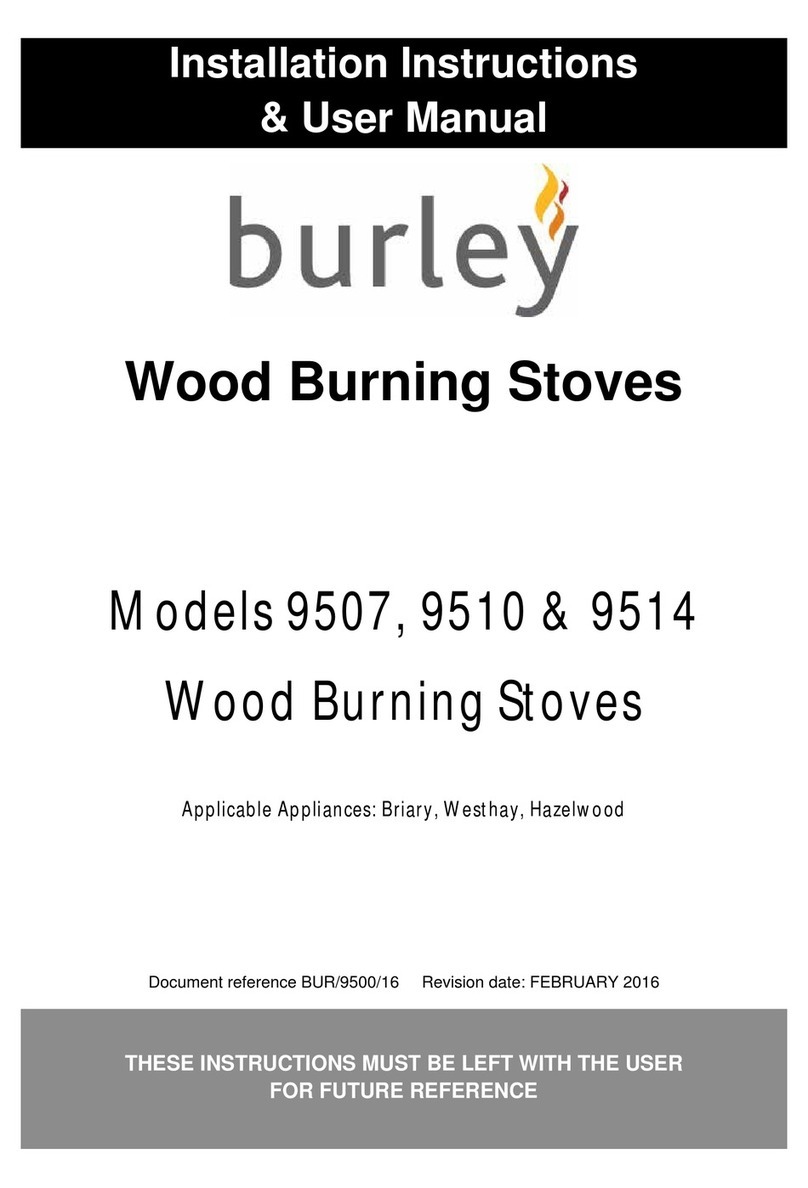
Burley
Burley 9507 Installation instructions & user manual

EVA Stampaggi
EVA Stampaggi 8KW instruction manual
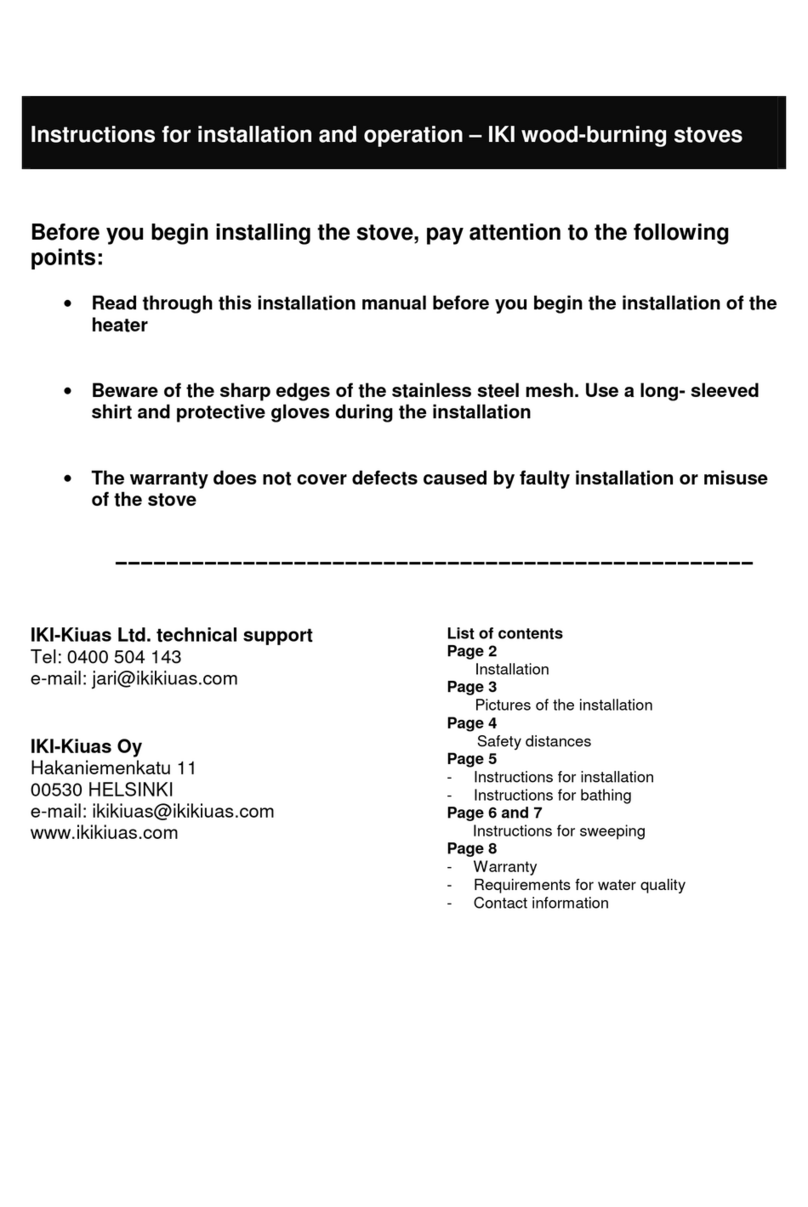
IKI-Kiuas
IKI-Kiuas Original IKI Instructions for installation and operation

Jøtul
Jøtul F 602 CB Installation and operation instructions

Pacific energy
Pacific energy MIRAGE 30 SERIES A Installation and operating instructions
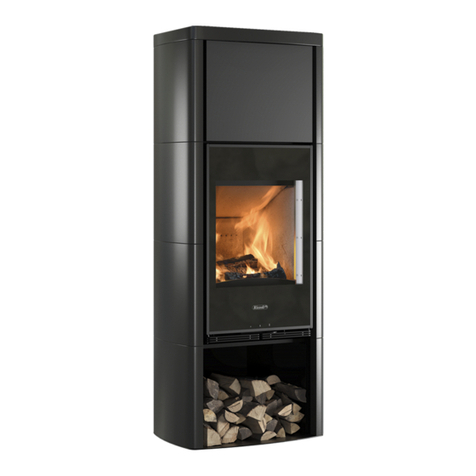
Rizzoli
Rizzoli X Series instructions
